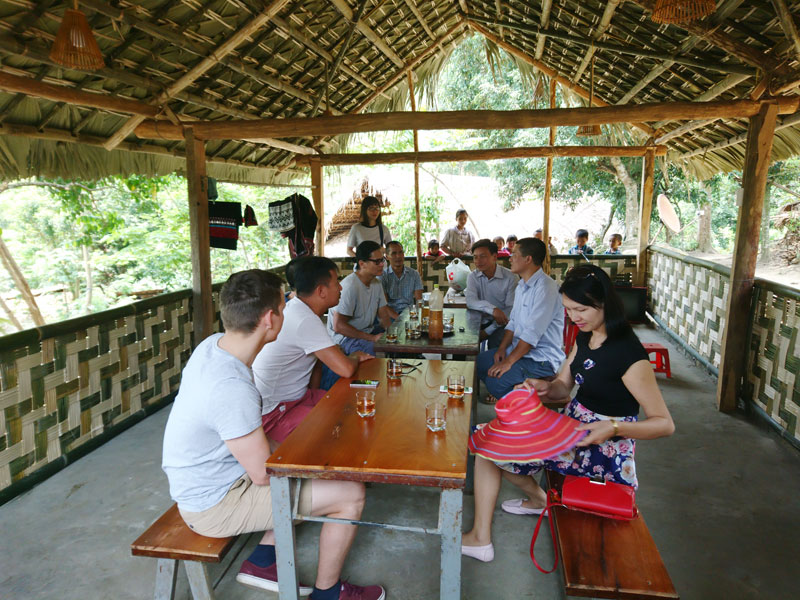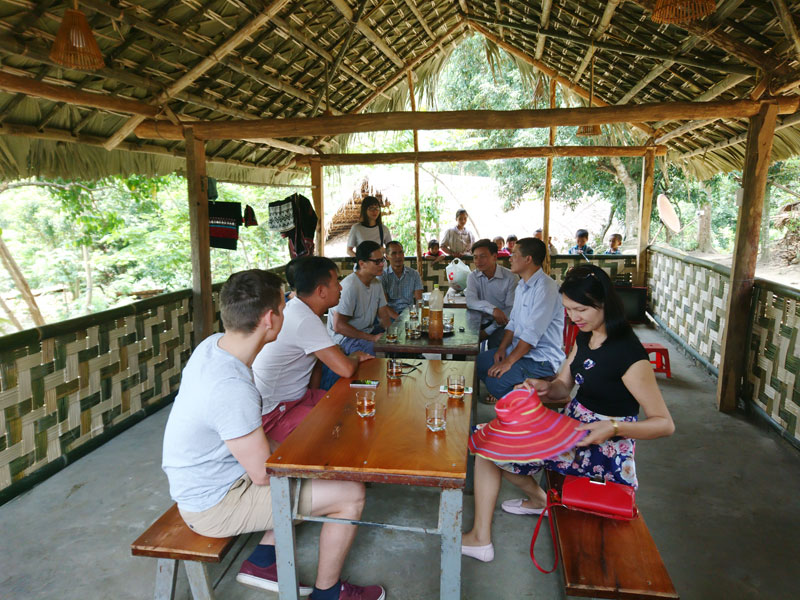
(HBO) - In recent years, the model of community tourism of Da Bac district built has been attracting domestic and foreign tourists. Besides the community tourism destinations of Ke hamlet (Hien Luong commune), Da Bia hamlet (Tien Phong commune), Sung village (Cao Son commune) has been developing the community for nearly 3 years but is now attractive to visitors for experimenting, discovering the majestic natural scenery of the upland Da Bac.

Domestic and foreign visitors visit,
experience at community tourism attractions in Sung village, Cao Son commune
(Da Bac).
Sung village is located at an altitude of
about 530 meters above sea level, behind is the majestic Bieu mountain range,
at the foot is the terraced rice, stretching along the romantic hillside.
Around the village, there are hiking trails up to the mountain, through
streams, terraces and production areas of the local people. Ms. Ly Sao Mai, the
coordinator of Da Bac Community Tourism Company in Sung Hamlet, said that: in
Sung village, there are 73 households, of which 100% are Dao ethnic group. This
is a place that preserves the traditional cultural values of the Dao Tien
ethnic people and is being preserved and invested to develop the community
tourism. Coming to Sung Hamlet, visitors will not only be able to explore the
local culture, learn customs, traditional customs, architecture of houses and
life of local people but also enjoy national ethnic cuisine, such as:
mountainous chickens, stream fish, forest young bamboo, Can wine, Hoang wine,
etc. Specially, they can experience with the local people through activities
such as rice transplantation, forest planting, husbandry, cooking rice,
fishing.
At present, there are 3 household running tourism
businesses in the village: Thanh Chung, Xuan Lan, Nhat Quy and a showroom
introducing and selling products of Ms. Ly Thi Tien's family. Especially, more
than 90% of households still keep the houses with ground land, traditional
roofs of palm leaves of the Dao ethnic group. The people here still keep and
preserve traditional weaving from the dyeing of indigo, weaving, embroidery of
skirts, dresses, and printing patterns on skirts by beeswax. In addition,
visitors who want to find out more about other attractions can go by motorbike
about 1 hour or walk (there are 3 routes to choose: 6 hours, 10 hours and 13
hours) to Da Bia village. - a community tourism site of Muong ethnic group in
Tien Phong commune. From there, they can take a boat to visit the tourist spots
on the romantic Hoa Binh Lake.
Located just a 20-minute drive from Hoa Binh City, Ora Hill Farmstay & Glamping Hoa Binh is a captivating new destination nestled in Mo hamlet, Bình Thanh commune, Cao Phong district. Combining farming with leisure, this tranquil retreat is perfect for those seeking balance, joy, and an immersive experience in the expansive beauty of nature.
Muong Bi - Tan Lac is renowned as one of the four famous Muong regions in Hoa Binh province. Blessed by nature with a favourable climate and stunning landscapes, Tan Lac holds great advantages for tourism development. The local tourism industry has made remarkable strides in recent times thanks to the attention and support from the local authorities and sectors.
With its strategic location, well-developed transport network, and diverse soil and climatic conditions, Hoa Binh is emerging as a must-visit destination in Vietnam's northwestern tourism corridor. The province boasts numerous attractions, including the Kim Boi hot springs (Kim Boi district), the Dau Rong cave complex (Cao Phong), the Mai Chau valley (Mai Chau), and the iconic Hoa Binh hydropower plant.
The northern mountainous province of Hoa Binh has been listed among the 71 most beautiful places to visit worldwide by the prestigious US travel magazine Condé Nast Traveller.
Hoa Binh province’s rich natural and cultural resources position it as a prime location for developing community-based tourism (CBT). In recent years, support from central and provincial policies, as well as assistance from non-governmental organisations, have encouraged local ethnic minority and mountainous communities to actively engage in the sector.



